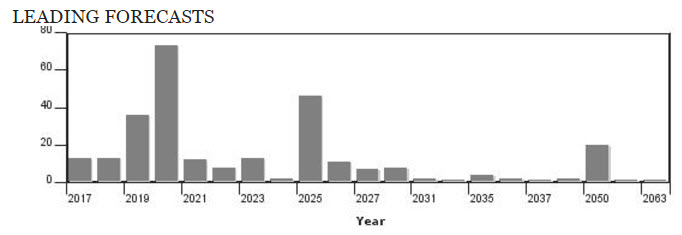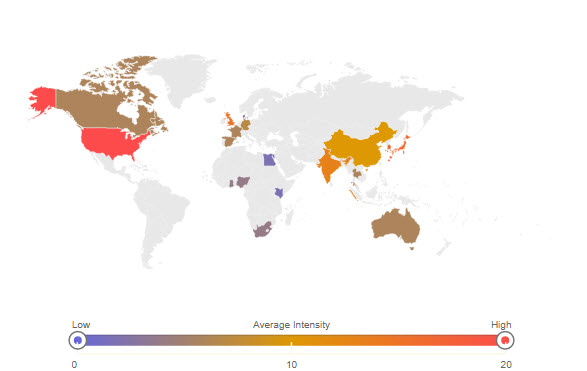
The race to build smart cities is on, but unless you have deep pockets or a unique, protected or niche product this is potentially an area to steer clear of as the substantial payback is likely to be a long way off. Read on to discover where the opportunities are.
- city
- More than 25 cities around the world could be described as "smart cities".
- Cities will not fundamentally look different in the next 10 years.
- Nigeria needs smart cities that will link infrastructure and innovation to make cities more efficient.
- A scenario planning method that could be employed by Sidewalk Labs and the City of New York is to involve New York citizens and understand their pain points in order to build a smart city solution which is beneficial for all stakeholders involved.
- IT companies in Nigeria will have the chance to team up with cities and infrastructure companies to help advance smart city / smart infrastructure technologies and systems in Nigeria.
- Nvidia is betting on predictions there will be over a billion cameras throughout cities by 2020.
- By 2050, over 9 billion people will inhabit the globe and 7 billion of them will being living in cities.
- Some of the global smart cities will be sharing the standards driven approach they have adopted for building smart cities in their countries.
- In Canada's smart cities, buildings will conserve more energy.
- In Canada's smart cities, traffic lights will adapt to ease congestion and speed up the flow of people and goods.
- By 2025, 25 Global Cities will be smart cities.
- Indian smart cities could take a lead from the Yokohama example for maximising their waste water management.
- Many IoT efficiencies will come to Las Vegas in other, non-monetary forms like cleaner air, reduced traffic congestion, improved emergency response time and increased tourism to the smart city circa 2025.
- The Code for Smart Communities will set new benchmarks for smart cities and communities across Australia.
- The global market for smart cities will reach US$3.5 billion by the year 2026.
- The number of Internet of Things devices used to spark the "smart" in smart cities is projected to surge six-fold in the next decade.
- People will live in smart cities that are part of a global ecosystem where consumer demand drives logistics and cargo handling industry.
- AP capital Amaravati will be developed as a smart city but with the help of the UK government.
- By 2020, smart cities will use 1.39 billion connected things to deliver sustainability and accomplish climate change goals.
- Projects like smart cities & Atal Mission for Rejuvenation & Urban Transformation is expected to lead a surge in the demand for cement.
- Sales of IoT devices and services related to smart cities alone reached $51.96 billion in 2015 and is expected to grow to nearly $147.51 billion in 2020.
- G3ict and World Enabled will launch a set of tools to help Smart Cities really become Smart Cities for All.
- Mega-cities will proliferate and the global market for "smart city" environmental services is estimated at $750 billion.
- By 2020, 10% of smart cities will use streetlamps as the backbone for a smart city WAN.
- Research firm IHS predicts there will be at least 88 smart cities worldwide by 2025.
- City Councillors from Europe and Korea who have implemented smart city projects global smart cities will share their standards driven approach.
- The United Kingdom has determined that smart cities will be a $400 billion market by 2020.
- The global market for smart cities could be worth $400 billion per year by 2020.
- Smart cities will represent a market value of USD1.565 Trillion by 2020.
- The global market for smart cities is projected to skyrocket to US$1.2 trillion by the year 2020.
- Smart cities are expected to provide $22 trillion in savings by 2050 with initiatives such as public transportation systems and energy-saving buildings.
- Today global cities are projected to allocate $1.5 trillion in resources by 2021 on the path toward becoming smart cities.
- Smart Energy GB revealed that a surge in urban expansion, economic growth and the integration of new technology will lead to UK cities embracing renewable energy sources as part of a transition to smart cities.
- IoT will generate up to $11.1 trillion a year in economic value by 2025 and smart cities are expected to contribute up to $1.6 trillion out of it based on applications like public safety, healthcare, traffic control and resource management.
- Asia-Pacific is expected to account for 32 smart cities in nine years' time.
- While the combined Europe, Middle East and Africa region represented the largest number of smart cities in 2013, Asia-Pacific is expected to take over the lead in 2025.
- There are expected to be at least 88 smart cities all over the world by 2025.
- Smart cities are also vital for tourism in Spain and will play a huge part in the growth of the industry.
- The jet-setting city of Dubai will offer the world's first autonomous air taxi service.
- solution
- The rate of urbanisation in South-East Asia will increase from 48% in 2015 to 65% by 2050 and there is mounting pressure on governments to find solutions to challenge and improve their efficiency in the distribution of public services.
- Mixing the seven dimensions of digital technology offers a potential solution to critical infrastructure needs and will enable countries such as Ghana to capitalise upon the very real benefits that come out of smart city development.
- India PSIM market is expected to grow at a robust pace on account of growing requirement and adoption of security solutions and increasing number of smart city projects.
- A scenario planning method that could be employed by Sidewalk Labs and the City of New York is to involve New York citizens and understand their pain points in order to build a smart city solution which is beneficial for all stakeholders involved.
- The annual global economic impact potential from the transition to smart city solutions and services is expected to be between $930 billion and $1.7 trillion by 2025.
- Asia's demand for smart city solutions will heighten over the next five years with China, Japan, and South Korea now accelerating adoptions of smart light, meter, building, and transportation.
- The global market for smart city solutions and services is expected to grow from $40.1 billion in 2017 to $97.9 billion in 2026.
- Versatility and cost effectiveness are set to be the foundations upon which the IoT solutions that will empower smart city development in the coming years will be reliant.
- market
- The market for smart cities technology will grow to $27.5 billion worldwide by 2023.
- The bus market in India is expected to be worth US$10.34 billion by 2020.
- Cumulative smart cities market is expected to be $1.565 trillion by 2020.
- On the flip side, new business models and an influx of new players from the Asia-Pacific will make the future market a fragmented one.
- The global market for smart cities will reach US$3.5 billion by the year 2026.
- The global market for refrigerated road transportation is expected to grow more than 26 percent between 2017 and 2021.
- Mega-cities will proliferate and the global market for "smart city" environmental services is estimated at $750 billion.
- The global market for smart cities could be worth $400 billion per year by 2020.
- The global market for smart cities is projected to skyrocket to US$1.2 trillion by the year 2020.
- Canada's resources and manufactured goods will make their way to global markets through better ports and airports.
- The global market for integrated city systems alone is expected to be worth more than $250 billion p.a. by 2030.
- The global market for smart city solutions and services is expected to grow from $40.1 billion in 2017 to $97.9 billion in 2026.
- The global smart cities market is projected to grow at a CAGR above 20% during 2017.
- The global smart cities market is expected to hit $34 billion by 2020.
- Opportunity abounds with the global smart cities market expected to reach $34.35 billion by 2020.
- A recent report predicted that the global smart cities market could be worth $3.5 trillion by 2026.
- Growing demand for centralized control systems coupled with increasing focus of businesses towards the enhancement of incident management and situational awareness for real-time situation management are expected to aid India PSIM market over the next five years.
- India PSIM market is expected to grow at a robust pace on account of growing requirement and adoption of security solutions and increasing number of smart city projects.
- Property developers-the global market for smart city services could reach as much as $225.5 billion in 10 years.
- The smart solar market in North America is expected to hold a colossal share by 2025.
- The Asia-Pacific region is expected to have the largest smart city market share and the highest growth rate: North America and Europe will have the second and third largest market shares by 2022, but will experience slower growth.
- initiative
- Smart cities are expected to provide $22 trillion in savings by 2050 with initiatives such as public transportation systems and energy-saving buildings.
- The Housing for All by 2022 initiative will be a major game-changer for the construction industry in India.
- Smart city initiatives and new regulations are expected to help the smart waste management segment could be worth $2.37 billion by 2021 at a compound annual growth rate of 16.9 percent between 2016 and 2021.
- Smart city initiatives and new regulations are expected to help the smart waste management segment expand at a compound annual growth rate of 16.9 percent between 2016 and 2021.
- economy
- The global smart cities economy is going to hit an estimated$ 1.4tn [£1.09bn] by 2020.
- investment
- Cities' investment in Internet of Things technologies will increase by $97 billion from 2015-2019.
- Rwanda will need foreign investment and foreign ICT companies and developers.
- Smart city investment is expected to reach $88.7 billion by 2025 in comparison to $36.8 billion in 2016 with funding projects such as the US White House's "Smart Cities initiative" further fuelling demand.
- In North America, smart city investments are expected to grow from $3 trillion in 2017 to about $9 trillion by 2023.
- By 2026, smart city investment is expected to reach $750 billion in North America.
- smart waste managementsegment
- Smart city initiatives and new regulations are expected to help the smart waste management segment could be worth $2.37 billion by 2021 at a compound annual growth rate of 16.9 percent between 2016 and 2021.
- Smart city initiatives and new regulations are expected to help the smart waste management segment expand at a compound annual growth rate of 16.9 percent between 2016 and 2021.
- technology
- India needs to extensively remodel its urban public utilities systems and existing urban infrastructure to embed technology that will make it easier to monitor them.
- 36 European island representatives signed a pledge to invest in digital technology that will fuel Europe's energy transition.
- Mixing the seven dimensions of digital technology offers a potential solution to critical infrastructure needs and will enable countries such as Ghana to capitalise upon the very real benefits that come out of smart city development.
- Smart Energy GB revealed that a surge in urban expansion, economic growth and the integration of new technology will lead to UK cities embracing renewable energy sources as part of a transition to smart cities.
- The market for smart cities technology will grow to $27.5 billion worldwide by 2023.
- IT companies in Nigeria will have the chance to team up with cities and infrastructure companies to help advance smart city / smart infrastructure technologies and systems in Nigeria.
- installation
- China smart meter installations will grow at a 21% CAGR to reach 349 million in 2020 through vendors like Itron, Echelon, Huawei.
- service
- Sales of IoT devices and services related to smart cities alone reached $51.96 billion in 2015 and is expected to grow to nearly $147.51 billion in 2020.
- The annual global economic impact potential from the transition to smart city solutions and services is expected to be between $930 billion and $1.7 trillion by 2025.
- The jet-setting city of Dubai will offer the world's first autonomous air taxi service.
- The power and breadth of Huawei's cloud and IoT platforms will allow any enterprise to harness the IoT and develop global, innovative digital products or services.
- Virtual Singapore is a collaborative platform with a rich data environment and visualization techniques that will be used by Singapore's citizens, businesses, government and research community to develop tools and services that address the emerging and complex challenges Singapore faces.
- The global market for smart city solutions and services is expected to grow from $40.1 billion in 2017 to $97.9 billion in 2026.
- Smart city revenue from services is expected to grow from $36.8 billion in 2016 to $88.7 billion by 2025!
- Mega-cities will proliferate and the global market for "smart city" environmental services is estimated at $750 billion.
- The rate of urbanisation in South-East Asia will increase from 48% in 2015 to 65% by 2050 and there is mounting pressure on governments to find solutions to challenge and improve their efficiency in the distribution of public services.
- Property developers-the global market for smart city services could reach as much as $225.5 billion in 10 years.
- By 2020, Australians will enjoy a 5G wireless internet service with speeds 100 times fast than the current NBN.
- Trend
Much of what is being written on Smart Cities focuses on the 2020 timeframe and is about short-term improvements to transport, buildings and energy use through use of IoT and predictive analytics. Longer forecasts predict big and growing markets but forecasts vary widely as the eventual outcome.

Sentiment Analysis
Sentiment has been positive on the rise of Smart Cities since the outset but has seen some steep drops in recent months due to concern that the market is over-hyped.

Topic map
The topic map suggests that mega investments in technology by business and governments alike will be needed to get past the hype and deliver the many social improvements that are promised by Smart Cities. Given the long implementation timeframes that investment may dry up if another global recession rears its head.

Heat map
The heat map shows a very polarized market with great swathes of South America, Africa, Northern Europe and South-East Asia not yet seeking to create Smart Cities.
Athena: Our robot, has determined which forecasts should be included in this Trend Alert. She found 973 forecasts in seconds to allow us to publish this summary in less than thirty minutes. She can turn these into PowerPoint slides and Audio files in minutes too as you wish.
Athena does show duplicates to aid your understanding of themes as well as contradictory forecasts. She may also show near-duplicates. You can speed read past the duplicates and near-duplicates if you wish, though the latter may show additional information. You can use the contradictory, and likely uncertain forecasts she finds to imagine different scenarios. The future is unpredictable but we can examine the possibilities and choose our preferable future from the choices she presents.
Keep up to date: You can stay bang up to date on this topic or choose from our many automatic reports to determine what's next in seconds.
Social changes | Sector prospects | Risks & opportunities | Year-by year | G20 watch | Key Organizations
You can also ask us to set-up private topics for you (clients only) to achieve the same thing as this Trend Alert for your associates or set up
Email subscriptions (Registration required) on your favourite subjects.